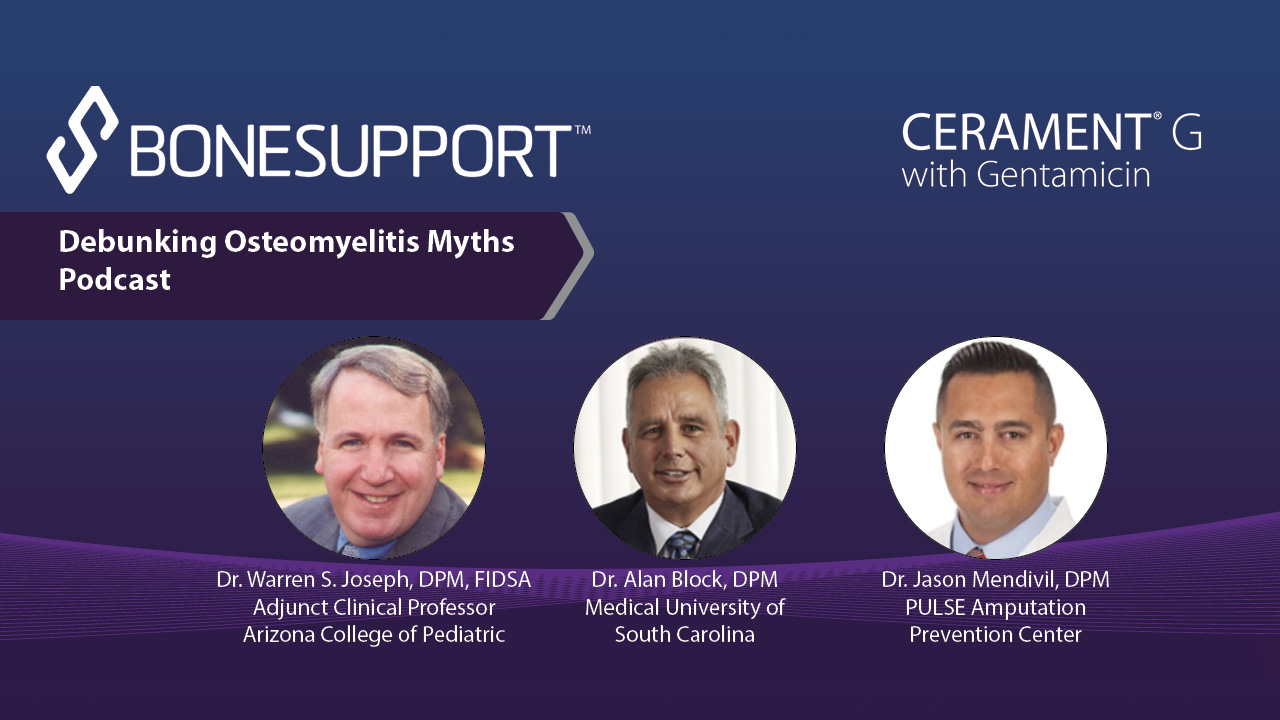Diabetic Foot Infection
20% of diabetic patients with infected foot ulcers have underlying osteomyelitis (Lipsky. 2014) and Murphy-Lavoie et al. report that 15% of diabetic patients will require an amputation (Murphy-Lavoie et al. 2020), but this can lead down a pathway of recurring infection and progressing higher amputations.
CERAMENT G remodels into bone whilst eluting antibiotic at high concentrations locally to protect the bone healing process. The antibiotic-eluting CERAMENT products offers the opportunity to pursue an alternative limb-sparing or salvage surgical pathway. Please have a look at our materials below on how to use antibiotic-eluting CERAMENT for best outcomes, example cases and clinical results.
Limb Salvage Surgery in Diabetic Foot Infection: Encouraging Early Results with a Local Antibiotic Carrier
Results:
- Fewer operations (1.2 vs. 3.5 per patient)
- Shorter hospital stay (12.6 vs. 25.1 days)
- Lower amputation rate (2% vs. 18%)
Adjuvant local antibiotic therapy in the management of diabetic foot osteomyelitis
Results:
- Lower five-year mortality rate (12.5% vs 55.1%, p<0.00001)
- Lower amputation rate (1.78% vs 12.24%, p=0.0484)
- Improved infection healing (73.21% vs 20.41%, p<0.0001)
- Persistence of infection with no evidence of wound healing at 6 months from surgery (7.14% vs 30.61%, p=0.00183)
Limb Salvage Surgery in Diabetic Foot Infection: Encouraging Early Results with a Local Antibiotic Carrier
Results:
- 47 patients
- 94% limb salvage rate
- 88% infection control and healing
Adjuvant Antibiotic Loaded Bio Composite in the Management of Diabetic Foot Osteomyelitis – A Multicentre Study
Results:
- 70 patients
- 90% infection eradication
- 12 week mean ulcer healing time
Single Stage Treatment of Diabetic Calcaneal Osteomyelitis with an Absorbable Gentamicin-Loaded Calcium Sulphate/Hydroxyapatite Composite: The Silo Technique
Results:
- 12 patients
- 0 fractures
- 100% infection eradication
Hear From the Experts
Podcast: Debunking Osteomyelitis Myths
Debunking Osteomyelitis Myths
This episode is sponsored by BONESUPPORT™, makers of CERAMENT® G – an FDA authorized, antibiotic-eluting bone void filler.
Warren Joseph DPM, FIDSA moderates a conversation about osteomyelitis in the foot and ankle with Alan Block, DPM and Jason Mendivil, DPM.
They not only discuss CERAMENT G and it’s uses, but antimicrobial stewardship, minimally invasive outpatient procedures, and the critical importance of preventing amputation.
AOFAS Podcast: Bone Infection Management Tools You Should Know
This episode is sponsored by BONESUPPORT™, makers of CERAMENT® G – the one and only FDA authorized, antibiotic-eluting bone void filler.
Kent Ellington, MD, from OrthoCarolina, moderates a conversation about the uses of CERAMENT G in foot and ankle procedures with Chris Kreulen, MD, from University of California – Davis Health, and Victor Anciano, MD, University of Louisville Health.
The conversation highlights the usage of CERAMENT G and the 2-CAN delivery device for hindfoot and TTC nailing, where CERAMENT G is delivered alongside intramedullary fixation to provide both bone remodeling and targeted local antibiotic delivery. The panel reviews and discusses several publications on single-stage procedures achieving infection eradication and intramedullary nailing with CERAMENT G as a reproducible technique.
ACFAS Podcast: DFO Management Tools You Should Know (If You Don't Already)
This episode is sponsored by BONESUPPORT™, makers of CERAMENT® G – the one and only FDA authorized, antibiotic-eluting bone void filler.
With Guest Presenters:
Brian Benson, DPM, AACFAS, DABPM
Beaugard Health System
DrRidder, LA
Bryon Collier, DPM, FACFAS, DABPM
Five Cities Foot and Ankle
Pismo Beach, CA
Gabriel Santamarina, DPM
Grady Memorial Hospital
Atlanta, GA



